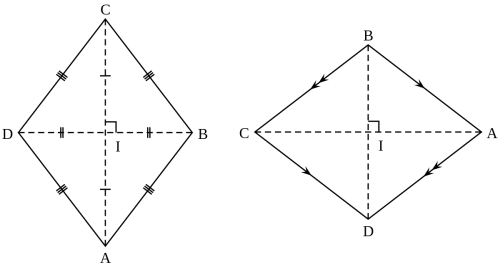If you have been on the internet looking for articles that explain the difference between a rhombus and a square, you have probably come across articles that say a square is actually a rhombus.
Is this correct? And if it is, what is the reason behind it?
If it isn’t correct, then what is the difference between a rhombus and a square?
Summary Table
| Rhombus | Square |
| Has two opposite internal angles that are equal | Has four right angles (90 degrees) |
| Sides are not perpendicular to one another | Sides are perpendicular to each other |
Descriptions

A rhombus is a parallelogram that:
- has four sides of equal length
- has two sides that are parallel
- has opposite sides that are parallel
- has opposite angles that are equal
- has perpendicular diagonals that are of unequal length
- has diagonals that form an interior right angle when they meet at the center
- has opposite angles that are of equal measure
Because of its appearance, a rhombus is also sometimes called a “diamond” or a square that is being pushed over to one side.

On the other hand, a square is a type of parallelogram that:
- has four sides which are all congruent (or of equal length)
- has four right angles (90 degrees)
- has diagonals that are of equal length
- has diagonals that bisect each other at 90 degrees
- has opposite sides that are parallel with all equal lengths
- has opposite angles that are also congruent
A square is technically a rhombus (it has parallel sides and perpendicular diagonals that bisect each other). It is also, by definition, a trapezoid, a kite, and a rectangle.
Rhombus vs Square
So if a square is a rhombus, then what is the difference between a rhombus and a square?
Both a rhombus and a square are parallelograms and quadrilaterals (which means they have four sides with parallel opposite sides). The main difference between the two is that, while a rhombus has two opposite internal angles of equal measure, a square has four right angles with equal measure.
Additionally, a rhombus does not have sides that are perpendicular to each other, unlike to a square.
In short, a rhombus that has right angles or angles that measure 90 degrees is considered a square. This means that a square is a rhombus, but not all rhombuses are squares.





